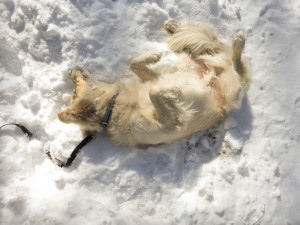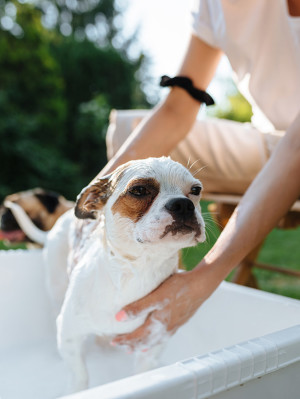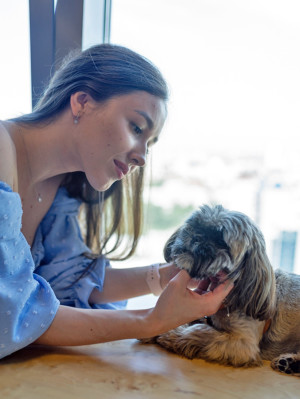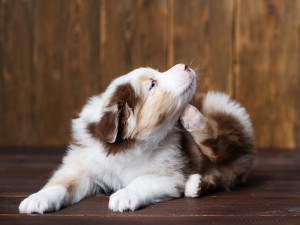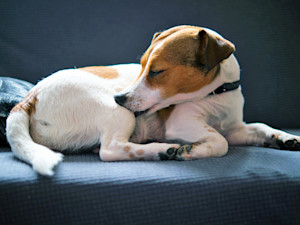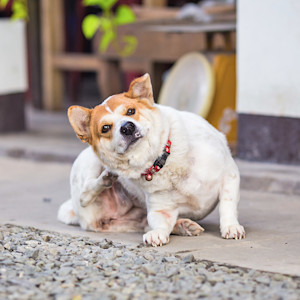Why Does Your Dog Have Dandruff?
So itchy and no fun.

Share Article
In This Article:
Dog Dandruff 101 Dog Dandruff Causes Dog Dandruff Treatments How To Prevent Dog Dandruff in Dogs
If you’ve noticed that your dog has flaky skin or their coat isn’t as lustrous lately, it may be dandruff. Dandruff can occur for many different reasons, one of which is caused by a direct problem with the skin cells, and others which have an underlying medical cause.
To get to the bottom of what’s causing your dog’s dandruff, you’ll need to see a vet. The good news is that there are many effective treatments for dandruff once you know the underlying cause.

Dog dandruff 101
Dandruff is defined as excessive scaling of the skin, caused by the shedding of dead skin cells. All animals normally shed dead skin cells, but when something disrupts the normal cycle of skin cell turnover, it may result in increased shedding of these cells. This causes dandruff or other changes in the skin.
What does dog dandruff look like?
Classic dandruff looks like light-colored flakes that are on the surface of the skin or caught in the fur. Depending on the underlying cause, some dogs with dandruff will also have other changes in their skin and coat including greasy fur, patches of hair loss, itchy skin, redness, a bad odor, or bumps on their skin.
Types of dog dandruff
There are multiple conditions that may be referred to as dandruff so it is important to see a vet to get a more specific diagnosis of what’s going on with your dog’s skin in order to treat it effectively. Some general categories of dandruff include:
Seborrhea sicca: This is the classic dry, flaky skin that we most commonly associate with dandruff. Dogs that have especially dry skin need treatments that will help to hydrate their skin while also treating their underlying condition.
Seborrhea oleosa: Other dogs have a more greasy feel to their skin and coat in addition to having flaky skin. These dogs will benefit from treatments that target this excessive oiliness.
Primary seborrhea versus secondary seborrhea: Primary seborrhea refers to dogs that have a defect in their skin cells that causes excessive flakiness. This is usually a genetic condition that starts in young dogs. Secondary seborrhea refers to cases where dogs acquire the condition later in life due to some other underlying condition like other skin disorders or systemic disease.
Walking dandruff in dogs: This is a unique condition that isn’t actually dandruff at all but a kind of mite called Cheyletiella. These mites live on the surface of the skin and look similar to flakes of dandruff, but they move, leading to the nickname, walking dandruff. Luckily, these flaky mites are easy to treat with many topical anti-parasitic medications.
Dog dandruff causes
Most cases of dandruff in dogs are secondary seborrhea, meaning there is some other medical problem affecting that is leading to the dandruff. Some of the common underlying causes include:
Allergies
Many dogs suffer from food or environmental allergies, which cause inflammation and irritation of their skin.
Skin infections
Dogs with skin infections from bacteria, yeast, or even skin parasites like fleas or skin mites will also have a lot of damage to their skin.
Genetic conditions
Primary seborrhea, or a direct dysfunction of the skin cells, is often an inherited condition seen in spaniel breeds, German Shepherds, Westies, and Bulldogs.
Systemic disease
Hormone imbalances caused by conditions like hypothyroidism, Cushing’s disease, or diabetes can affect the normal composition of the skin as well.
Nutrition
Poor nutrition, an imbalanced diet, or food allergies can also affect the skin.
Dry skin
Excessively dry skin can be the result of environmental conditions if you live somewhere that is very dry. It can also be due to over-bathing your dog which can strip their skin and coat of the natural oils that protect it.
Dog dandruff treatments
Dog dandruff is a broad category that includes many different conditions so it makes sense that treatment really needs to be tailored to your dog’s specific signs and underlying medical needs. A dog living in the desert with dry skin will need very different treatments from a dog with unregulated hypothyroidism, for example. Once your vet has made a specific diagnosis, treatments can be curated to your dog’s needs. Some common ways to treat dog dandruff include:
Bathing
Dog dandruff shampoos can target specific problems related to dandruff and other underlying skin disorders. While some dogs with dandruff have very dry skin, others have a more oily or greasy coat. Different shampoos will target dry skin versus oily skin, so it may take some trial and error to find the one your dog tolerates best. If your dog has additional skin conditions, like an infection or allergies, your vet may recommend a medicated shampoo that also targets these conditions.
Topicals
Topical medications may be applied directly to the surface of the skin. These are often used in combination with other treatments as it can be difficult to apply topical treatments all over your dog. Some common topical treatments include omega-3 and omega -6 fatty acids which can reduce inflammation and improve moisture levels in dry skin, and antimicrobial sprays to control secondary infections from yeast or bacteria.
Preventative care
Staying on top of routine deworming and flea and tick preventatives is important for all dogs, but is especially important for any dog with a skin condition. If your dog’s skin is already inflamed and fragile, a flea infestation will be even more uncomfortable and damaging to their skin. Dogs with skin conditions should be on year-round flea preventatives to provide them with that extra level of protection.
Diet and supplements
It is important to make sure your dog eats a complete-and-balanced dog food diet that is appropriate for their stage of life to ensure all of their nutritional needs are met, and this also supports healthy skin and coats. Some dogs with skin conditions may need to eat a specialized diet if they have a food allergy or if they need to increase their fatty acid intake. Other supplements like fish oils and probiotics may also support healthy skin. For specific forms of dog dandruff, additional supplements like vitamin A may be part of their treatment protocol as well.
Grooming
Routine brushing and grooming is also an important part of maintaining healthy skin and coats. Matted fur is painful and can also be unsanitary. For dogs who are undergoing treatment for dandruff, it can be helpful to keep their coat trimmed short; this will allow shampoos and topical products to reach the skin more effectively.
How to prevent dog dandruff in dogs
Do all that you can to promote a healthy skin and coat routine for your pup. This includes making sure they eat a complete and balanced dog food diet, receive routine brushing and grooming, and have year-round preventative care like flea and tick treatments and dewormings.
Not all causes of dandruff are easily prevented, so if your dog is showing signs of a skin problem, be sure to see a vet right away to determine the underlying cause and start an appropriate treatment. Skin conditions have a tendency to snowball as secondary problems develop, leading to more damage and discomfort, so it is best to nip these problems in the bud and treat them right away. The sooner you can get a handle on what’s causing your dog’s dandruff, the sooner they will get relief and get back to their floofy selves.
Bottom line
Dandruff is a catch-all term for many different skin conditions that cause flaky or greasy coats.
The underlying causes for dandruff include other skin conditions as well as systemic illnesses.
Be sure to see your vet in order to get an accurate diagnosis for your dog’s dandruff so that it can be treated effectively.
References
Heinrich, N. “Seborrhea in Animalsopens in new tab,” Merck Veterinary Manual, September 2024.
Lundber, A, et al. “Diagnosing Common Skin Conditions of Dogs and Cats in Community Medicine Practiceopens in new tab,” Today’s Veterinary Practice, May/June 2022.
Nuttall, T, et al. “Update on pathogenesis, diagnosis, and treatment of atopic dermatitis in dogsopens in new tab.” Journal of the American Veterinary Medical Association, 1 June 2019, vol. 254, no. 254, pp. 1291-1300.

Dr. Amy Fox, DVM
Amy Fox, DVM is a small animal veterinarian in New York City with over thirteen years of experience in a mixture of general practice, emergency medicine, and shelter medicine. A lifelong animal lover, Dr. Fox studied biology in college and then worked as a veterinary nurse before pursuing veterinary school at Cornell University. Her expertise includes surgery, dentistry, and management of chronic conditions, and she is interested in toxicology, pain management, nutrition, care of senior pets, and educational outreach. Dr. Fox also enjoys writing about veterinary medicine and teaching, and her work has previously appeared in Spruce Pets. In her free time, she loves to cook, garden, go for long runs, and hang out with her goofy mixed-breed dog May, who provides never ending comic relief!
Related articles
Can Dogs Get Sunburns? Signs, Treatment
It’s good to know ahead of all the summer fun you’re gonna have together.
Can Dogs Get Pimples? Causes, Symptoms, and Treatments
Time to go to the doggie dermatologist!
Can Dogs Get Skin Tags? Causes and Treatments
Yes, and here’s why you shouldn’t pick at them, even if you want to.
![Fluffy brown and white puppy dog scratching a lot with its paw]()
Your Itchy Dog Deserves Relief—Here’s What to Do
Thankfully, there are treatments. But first, you have to figure out why they have an itch to scratch.
![Small brown and white dog biting itself.]()
13 Common Dog Skin Conditions
Our experts explain signs, symptoms, and treatments.
![Itchy dog try to scratching its skin.]()
Top 6 Reasons Why Your Dog Is Itching and Losing Hair
No fleas, but still itching? Here’s (maybe) why.
